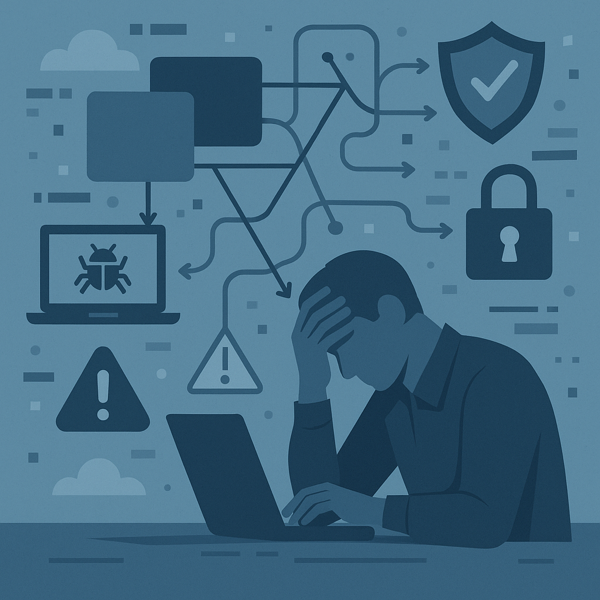Security operations teams today are strained under the weight of fragmented, multi-vendor tool ecosystems that impede response times, obscure visibility, and generate needless friction.

Recent research paints a troubling picture: in the UK, 74% of companies rely on multi-vendor ecosystems, causing integration issues and inefficiencies. Globally, nearly half of enterprises now manage more than 20 tools, complicating alert handling, risk analysis, and streamlined response. Equally alarming, some organizations run 45 to 83 distinct cybersecurity tools, encouraging redundancy, higher costs, and brittle workflows.
Why It’s Urgent
This isn’t theoretical—it’s being experienced in real time. A recent MSP-focused study shows 56% of providers suffer daily or weekly alert fatigue, and 89% struggle with tool integration, driving operational burnout and missed threats. Security teams are literally compromised by their own toolsets.
What Organizations Are Trying
Many are turning to trusted channel partners and MSPs to streamline and unify their stacks into more cohesive, outcome-oriented infrastructures. Others explore unified platforms—for instance, solutions that integrate endpoint, user, and operational security tools under one roof, promising substantial savings over maintaining a fragmented set of point solutions.
Gaps in Existing Solutions
Despite these efforts, most organizations still lack clear, actionable frameworks for evaluating and rationalizing toolsets. There’s scant practical guidance on how to methodically assess redundancy, align tools to risk, and decommission the unnecessary.
A Practical Framework for Tackling Tool Sprawl
1. Impact of Tool Sprawl
- Costs: Overlapping subscriptions, unnecessary agents, and complexity inflate spend.
- Integration Issues: Disconnected tools produce siloed alerts and fractured context.
- Alert Fatigue: Driven by redundant signals and fragmented dashboards, leading to slower or incorrect responses.
2. Evaluating Tool Value vs. Redundancy
- Develop a tool inventory and usage matrix: monitor daily/weekly usage, overlap, and ROI.
- Prioritize tools with high integration capability and measurable security outcomes—not just long feature lists.
- Apply a complexity-informed scoring model to quantify the operational burden each tool introduces.
3. Framework for Decommissioning & Consolidation
- Inventory all tools across SOC, IT, OT, and cloud environments.
- Score each by criticality, integration maturity, overlap, and usage.
- Pilot consolidation: replace redundant tools with unified platforms or channel-led bundles.
- Deploy SOAR or intelligent SecOps solutions to automate alert handling and reduce toil.
- Measure impact: track response time, fatigue levels, licensing costs, and analyst satisfaction before and after changes.
4. Case Study Sketch (Before → After)
Before: A large enterprise runs 60–80 siloed security tools. Analysts spend hours switching consoles; alerts go untriaged; budgets spiral.
After: Following tool rationalization and SOAR adoption, the tool count drops by 50%, alert triage automates 60%, response times improve, and operational costs fall dramatically.
5. Modern Solutions to Consider
- SOAR Platforms: Automate workflows and standardize incident response.
- Intelligent SecOps & AI-Powered SIEM: Provide context-enriched, prioritized, and automated alerts.
- Unified Stacks via MSPs/Channel: Partner-led consolidation streamlines vendor footprint and reduces cost.
Conclusion: A Path Forward
Tool sprawl is no longer a matter of choice—it’s an operational handicap. The good news? It’s fixable. By applying a structured, complexity-aware framework, paring down redundant tools, and empowering SecOps with automation and visibility, SOCs can reclaim agility and effectiveness. In Brent Huston’s words: it’s time to simplify to secure—and to secure by deliberate design.
References
- Cybersecurity teams are wasting time, money, and effort dealing with tool sprawl and ‘multi-vendor ecosystems’ – IT Pro
- Cybersecurity complexity and the channel – IT Pro
- The risk we chose: when compromise becomes the default – TechRadar Pro
- Redefining SecOps: the intelligent future of SIEM – TechRadar Pro
- The risks of cybersecurity tool sprawl and why we need consolidation – HashiCorp
- Report reveals tool overload driving fatigue and missed threats in MSPs – CIO
* AI tools were used as a research assistant for this content, but human moderation and writing are also included. The included images are AI-generated.
